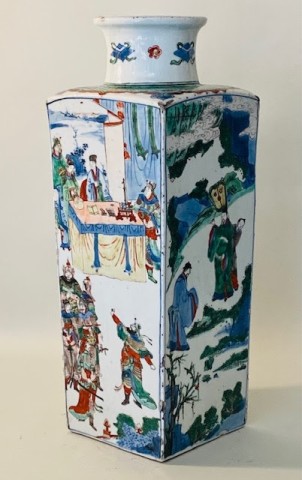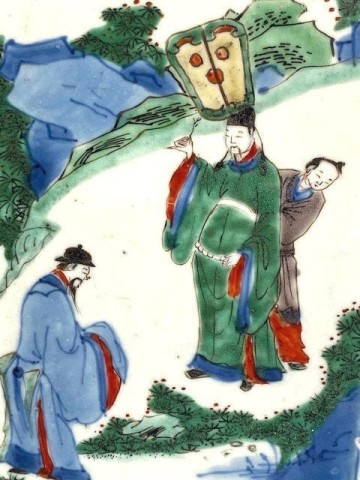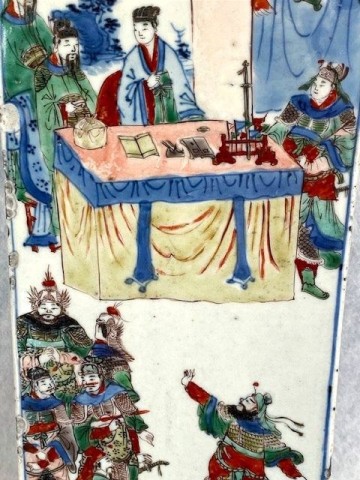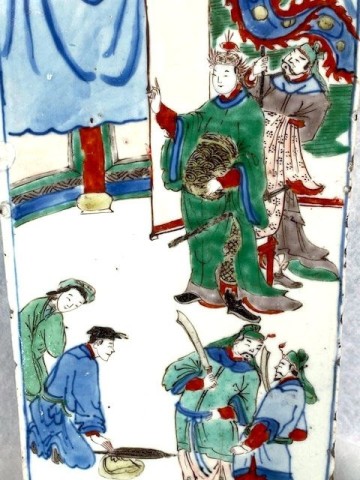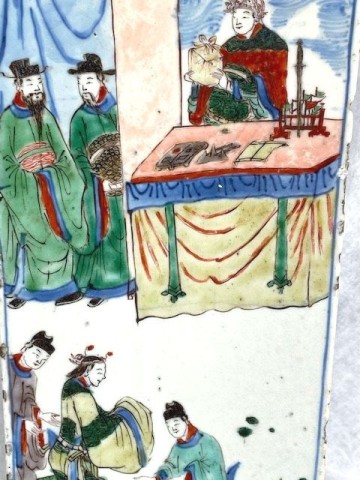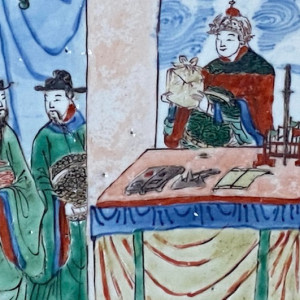BG61
Further images
The body with tapered rectangular sides supporting a waisted cylindrical neck and everted rim, each side painted in underglaze cobalt blue and bright enamels: shades of green, yellow, iron-red, aubergine and black, with legendary figures from classic stories including generals and scholars, the neck with florets and lozenges.
Literature
Intriguingly our vase appears to have scenes from different classics which in itself is highly unusual.
Panel one: 'The Generals of the Yang Family," in some cases also known as the Lady generals of the Yang clan. This episode depicts when the Liao emperor proposes a "Summit meeting" with his Song counter part; this in fact was a trap to ambush and kill the Song emperor. The young brothers or generals- there were seven of them- saw through this and asked the emperor not to attend the meeting but said that they would go in his place. The eldest brother pretended to be the king and he was subsequently killed, leaving behind the 4th, 5th and the 6th bother. The 4th brother was captured but he did not disclose his identity and subsequently married a Liao princess. The 5th brother escaped to a monastery and became a monk and finally, the 6th managed to return home and led the fight against the Liao army and carried on the work of his father.
Panel two: the man holding up what appears to be a " twig" ( it's a thorn hairpin); is from the drama of the same name, "The Thorn Hairpin", The Story of the Thorn Hairpin is an anonymous work written in the fourteenth century. Wang Shipeng, a poor scholar, was engaged to Qian Yulian, who accepted his engagement gift of a thorn hairpin. Later Wang passed the civil examination as the top scholar and declined the prime minister's offer of his daughter in marriage. Sun Ruquan, Wang's friend who sought to marry Qian, schemed to turn Wang's letter of welcome into a letter of divorce. The Qian family wrongly believed that Wang had become the son-in-law of the prime minister, thus forcing Qian to remarry. Qian refused, threw herself into the river in protest but was luckily rescued by a prefect of the same family name. Years later Wang and Qian meet again by accident and the family is finally reunited.
Panel 3: As yet unidentified
Panel 4: As yet unidentified
The scenes depicted on the vase have been taken from classic stories. These stories, some based on historical fact others purely fictional were handed down spread by word of mouth and professional storytellers as well as made into woodblock-printed novels and plays. In the case of the the mostly fictional saga, The Yang Generals , this was based on the lives of historical characters and can be traced back to at least the 13th century. The prints from the woodblock-printed novels were a major source of inspiration for the painters who retold the stories in pictures on 17th century porcelain. This rare vase appears to have scenes from at least two different classics.
Compare with a similar famille verte square baluster vase in the Metropolitan Museum.
Another wucai square vase of similar form and height is illustrated by C. Jörg, Chinese Ceramics in the Collection of the Rijksmuseum, Amsterdam, London, 1997, no. 78, pp. 86 and 87; AK-RBK-1955-8. Rijksmuseum, Amsterdam, where Jorg dates it to Shunzhi period, c.1645-1660.
